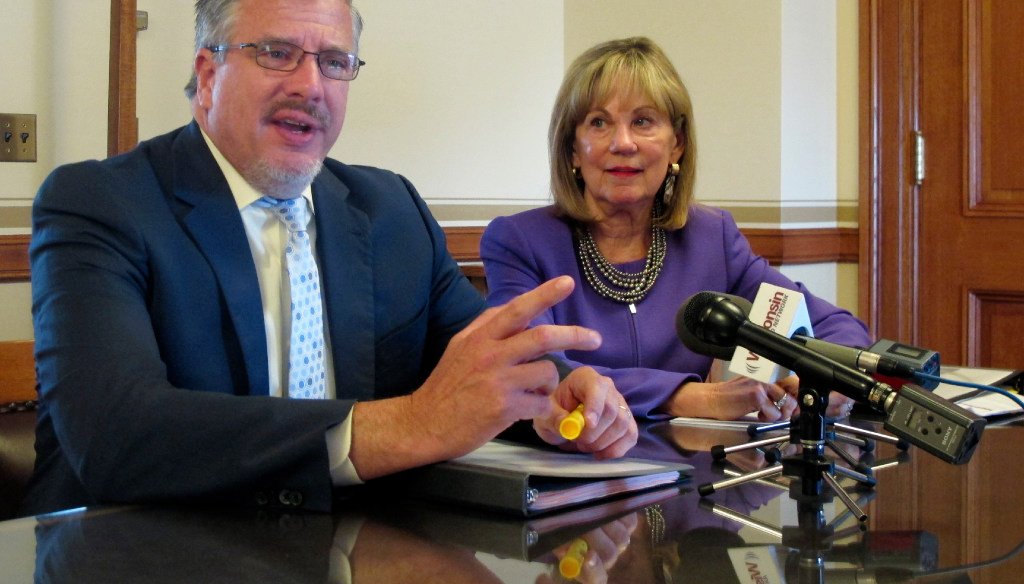

Our only agenda is to publish the truth so you can be an informed participant in democracy.
We need your help.


State Rep. John Nygren, R-Marinette
Not unreasonable to connect tax increases to welfare increases since both tie into the General Fund
But Evers specifically noted in his budget that he was leaving the agricultural component of a controversial tax credit in place
He did propose raising taxes on manufacturers, including those that use agricultural products. But an indirect potential impact is not the same as a tax increase
Wisconsin’s struggling farms were front and center in Gov. Tony Evers’ State of the State address.
He celebrated the state’s identity as America’s Dairyland. He bemoaned the loss of family farms in recent years. And he called for a special session of the Legislature to consider a package of agricultural bills.
All of which one Republican leader claimed was disingenuous.
"Governor Evers’ sudden concern for rural Wisconsin and our agriculture industry is ironic given that just a year ago he proposed raising taxes on the agriculture industry to pay for expanded welfare programs," state Rep. John Nygren, chairman of the powerful Joint Finance Committee, said Jan. 22, 2020 on Twitter and in a later news release. "No amount of rhetoric can cover his failed record of putting rural Wisconsin and our farmer(s) behind liberal special interests."
The budget claims from the Marinette Republican caught our eye.
Did Evers really try to raise taxes on agriculture to fund welfare?
Defending Nygren’s claim, his chief of staff Nathan Schwanz pointed to proposed changes to the Manufacturing and Agriculture Tax Credit.
Evers’ budget explicitly changed only half of that credit. He proposed limiting the credit for manufacturing to $300,000 per tax year. But the budget added, "The Governor also recommends leaving the agricultural portion of the credit unchanged compared to current law."
The changes would have reduced the tax credit — i.e. raised taxes — by a total of $289 million in 2020 and $237 million in 2021.
Schwanz said the proposed cut still would have been a blow to agriculture, however, pointing to a Legislative Fiscal Bureau memo from February 2019.
The nonpartisan agency, responding to a request from Nygren, found about 25% of the manufacturing and agriculture tax credits in 2018-19 went to manufacturers "where agricultural products are the primary input." Those were manufacturers of food, beverages, tobacco and basic chemicals.
So Evers didn’t propose any direct tax increases to agriculture, but his proposed changes for manufacturers would have reduced their income.
Nygren’s argument is that would have then affected agricultural producers by limiting the amount of product manufacturers took in.
Nygren also connected these cuts to welfare.
Evers’ proposed budget increased spending for welfare programs, so Schwanz said the proposed cuts to the manufacturing and agriculture credit were among the changes needed to offset that.
He summed up the logic this way:
"There is no doubt that the Governor’s budget increased General Fund taxes. There is no doubt that his budget expanded welfare and that these tax increases were needed to pay for it."
So there’s no direct link between the manufacturing tax credit and welfare. That is, Evers didn’t propose earmarking the credit savings for a welfare program.
But broadly speaking, a cut in one area does affect the ability to increase spending in another. The manufacturing tax credit is paid from the General Fund, which is used for all manner of welfare programs.
It’s an approach to budgeting that is used by fiscal bureau analysts and others, including Evers.
For example, in his 2017 annual education address, Evers, then the schools superintendent, said, "Every dollar we shift from the state coffers to pay for roads, and increasingly, to simply pay for debt, is a dollar we move out of the classroom of a child," the Wisconsin State Journal reported in a Sept. 22, 2017 article.
Nygren said the governor proposed raising taxes on the agricultural industry to expand welfare programs.
It’s not unreasonable to connect tax changes to welfare programs, since both tie into the General Fund and were part of the same proposed budget. Of course, that budget contained a multitude of other changes as well.
But Nygren is off base saying Evers proposed raising taxes on agriculture. Evers explicitly left the agriculture side of a tax credit alone, though some agriculture operations could have been indirectly affected since their products are used by manufacturers.
That leaves us with a statement that contains an element of truth but ignores critical facts that would give a different impression.
We rate Nygren’s claim Mostly False.
John Nygren news release, Gov. Evers Hides from Failed Policies, Jan. 22, 2020
Tony Evers, Executive Budget 2019-21, February 2019 (pg 451)
Wisconsin Legislative Fiscal Bureau, Estimated Manufacturing and Agricultural Tax Credit for Selected Types of Industries, Feb. 8, 2019
Email exchange with Nathan Schwanz, chief of staff for Rep. John Nygren, Feb. 11-12, 2020
Wisconsin State Journal, Tony Evers takes aim at GOP on school funding, Medicaid and roads in annual education address, Sept. 22, 2017
In a world of wild talk and fake news, help us stand up for the facts.
